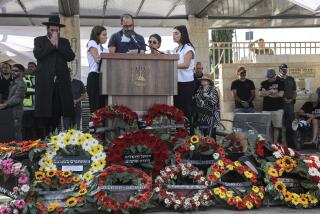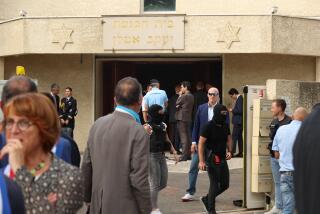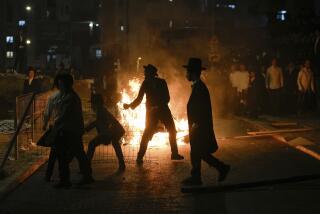Jerusalem synagogue attack: ‘The shock was not to be believed’
A scant hour after the day’s chilly dawn, the worshipers were in the midst of the “shemoneh esrei” -- the prayer that lies at the very heart of the Jewish liturgy. Then came blood and chaos.
“I suddenly heard shots,” said Yaacov Amos, 45, his voice shaking with agitation after witnessing the attack Tuesday on a Jewish house of worship in Har Nof, a normally tranquil Jerusalem neighborhood. “The shock was not to be believed -- in the middle of this prayer, of all prayers, here in our synagogue, before my very eyes, at a range of zero.”
At least four worshipers died in the deadliest assault in Jerusalem in six years -- one that sent Israel scrambling to its second-highest level of alert. Seven people were hospitalized, including at least one of the police officers who shot dead the two attackers, who were armed with firearms as well as axes and knives.
In the streets of Har Nof, the grief was palpable. A woman on a balcony overlooking the scene of the shooting pressed a hand to her mouth. One man shouted prayers aloud. Others frantically tapped at cellphones, trying to locate family members.
Rescuers from the mainly Orthodox Jewish disaster response group Zaka, wearing their trademark green gloves, hurried in and out of the ornate four-story building where the attack took place, which houses two synagogues and a yeshiva, or religious seminary. Once the wounded had been taken away in ambulances with sirens screaming, congregants moved to salvage sacred texts from the bloodied floors, carrying them carefully outside.
Despite weeks of street clashes in the city’s “seamline” areas -- those dividing Jerusalem’s predominantly Jewish western sector from the traditionally Arab east, few in the enclave of Har Nof believed the violence would touch them.
The devoutly religious neighborhood, set well inside the “Green Line” that marks Israel’s pre-1967 borders, moves to the timeless rhythms of pious Orthodox life -- study, rounds of prayers, nearly everyone dressed in the traditional garb of head coverings and long sleeves for women, black suits and hats for men. Yiddish can often be heard in the streets and shops.
“I can’t believe it happened in our quiet neighborhood,” said Los Angeles-born Esther Esses, 70, who lives close to the synagogue. “Seeing the border police here, hearing the shouting and gunshots ... the sense is one of enormous” -- she searched for the word, switching back and forth between English and Hebrew -- “disappointment.”
In keeping with the Jewish tradition of swift burials, the four funerals were held the same day in Jerusalem’s western hills, with thousands of people in attendance, under heavy police guard. One of those killed, U.S.-born Rabbi Moshe Twersky, was a member of a famed Hasidic dynasty. Two other victims were American citizens as well.
As funeral processions set out from the neighborhood, live broadcasts showed a sea of black hats and skullcaps as men of all ages swayed in prayer, some weeping as verses were recited.
“We must pray for peace,” said Mira Bagad, 44, who lives next to the synagogue. “We need the one above to intervene -- we can’t do it on our own.”
Zer is a special correspondent and King a staff writer. Special correspondent Batsheva Sobelman in Jerusalem contributed to this report.
More to Read
Sign up for Essential California
The most important California stories and recommendations in your inbox every morning.
You may occasionally receive promotional content from the Los Angeles Times.










